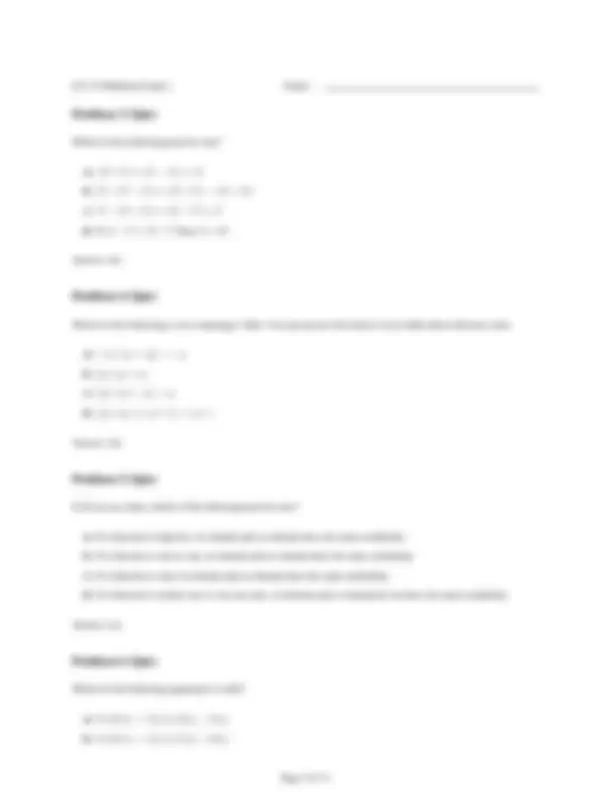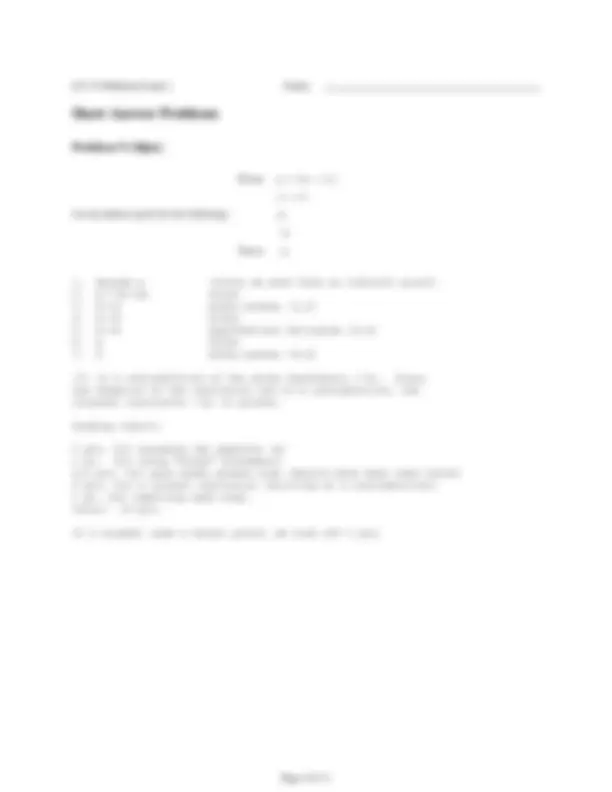








Study with the several resources on Docsity

Earn points by helping other students or get them with a premium plan


Prepare for your exams
Study with the several resources on Docsity

Earn points to download
Earn points by helping other students or get them with a premium plan
Community
Ask the community for help and clear up your study doubts
Discover the best universities in your country according to Docsity users
Free resources
Download our free guides on studying techniques, anxiety management strategies, and thesis advice from Docsity tutors
During the study of discrete mathematics, I found this course very informative and applicable.The main points in these lecture slides are:Logically Equivalent, Inverse of Converse, Contrapositive, Inference Rules, Tautology, Domain and Co-Domain, Bijective Function, Valid Arguments, Inverse Function, Power Set, Indirect Proof, Arbitrary Element
Typology: Exams
1 / 11

This page cannot be seen from the preview
Don't miss anything!







Name:
NetID:
Lecture Section:
Section Leader:
General Directions
Which of the following is logically equivalent to p → q?
a) q ∨ ¬p
b) the contrapositive of p → q
c) the inverse of the converse of p → q
d) all of the above
Answer: (d).
Which of the following is a negation of ∀x∀y[((x > 0) ∧ (y > 0)) → (x + y > 0)]?
a) ∃x∃y[(x > 0) ∧ (y > 0) ∧ (x + y ≤ 0)]
b) ∃x∃y[((x ≤ 0) ∨ (y ≤ 0)) ∧ (x + y > 0)]
c) ∀x∀y¬[((x > 0) ∧ (y > 0)) → (x + y > 0)]
d) ∃x∃y[(x ≤ 0) ∨ (y ≤ 0) ∨ (x + y > 0)]
Answer: (a).
c) ∀x(S(x) → L(x)), ¬S(a) ∴ ¬L(a)
d) ∃x(S(x) ∧ L(x)), S(a) ∴ L(a)
Answer: (a).
Let f (x) = 3x + 2 and g(x) = x^2 be functions defined on the integers (f : Z → Z, g : Z → Z). Which of the following is true?
a) g ◦ f = O(x^2 )
b) g ◦ f = O(x^3 ), and g ◦ f is not O(x^2 )
c) g ◦ f (x) = f ◦ g(x)
d) g ◦ f has an inverse function.
Answer: (a).
Which of the following is false?
a) {x} ⊆ {x}
b) {x} ∈ {x, {x}}
c) {x} ⊆ P({x}), where P({x}) is the power set of {x}
d) {x} ⊆ {x, {x}}
Answer: (c).
Use an indirect proof for the following:
Given: p → (m → w) w → d m ¬d Prove: ¬p
(7) is a contradiction of the given hypothesis (˜d). Since the negation of the conclusion led to a contradiction, the original conclusion (˜p) is proven.
Grading rubric:
2 pts. for assuming the opposite (p) 1 pt. for using "Given" statements 2,2 pts. for each modus ponens step (should have been used twice) 2 pts. for a correct conclusion (arriving at a contradiction) 1 pt. for labelling each step. Total: 10 pts.
If a student used a direct proof, we took off 3 pts.
Tell whether each of the following is True or False. The universe is all integers.
a) ∀z∀y∃x(x − y = z)
True
b) ∀y∃x∃z(x − y = z)
True
c) ∀x∀y∀z(x − y = z)
False. This is saying for all pairs of (x, y, z), it holds that x − y = z. Obviously, it is false.
d) ∀x∀y∃z(x − y = z)
True
e) ∀x∃y∃z(x − y = z)
True
f) ∃x∃y∀z(x − y = z)
False. This is saying, there exists a pair (x, y) such that x − y = z holds for any z. We know that for any fixed pair of (x, y), their difference is also fixed. Therefore, it is false.
g) ∃x∃y∃z(x − y = z)
True
h) ∃x∀y∀z(x − y = z)
False. It is saying there exists a particular x such that x − y = z holds for any pair of (y, z).
-1 point for each incorrect answer.
a) Let j and k be integers, with j even and k odd. Prove that the product of j and k is even.
j = 2n, and k = 2m + 1 for some integers n, m. Then jk = 2n(2m + 1) = 2z for some integer z. Thus, the product jk is even.
6 points for perfect answer. -2 points for not distinguishing m and n. -1 not concluding argument with the definition of an even number. -4 points for an answer that only specifies j and k, with no further argument. - points for an effort in the wrong direction.
b) Prove that the product of consecutive integers is even. Hint: you can use part a) in your solution.
Every pair of consecutive integers has one even and one odd. By part a) the product of such a pair is even.
7 points for perfect answer. -3 for restricting the least value to be even or odd. -1 point for other minor errors.
c) Prove that the square of an odd integer equals 8 k + 1 for some integer k. Hint: you can use part b) in your solution.
We wish to consider the square of an odd number: (2n + 1)^2. (2n + 1)^2 = 4n^2 + 4n + 1 = 4n(n + 1) + 1. Notice that from part b), n(n + 1) is even, so we have (2n + 1)^2 = 4(2k) + 1 for some integer k.
7 points for perfect answer. 2 points awarded for setting up problem and multiplying out the square without further argument. 4 points awarded for correct setup, multiplication, and factoring.